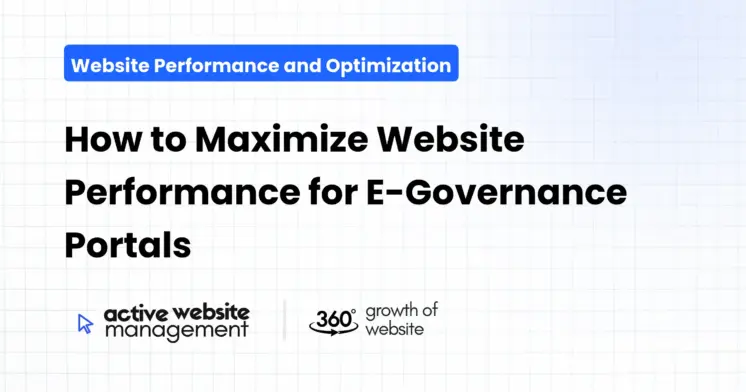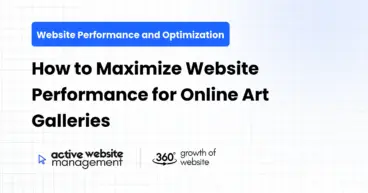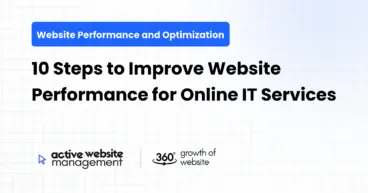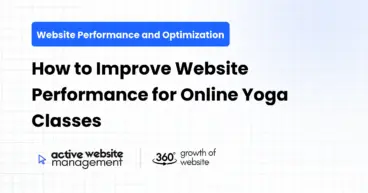February 4, 2025
16 min read
Imagine waiting in a long line at a government office, feeling frustrated and losing precious time. Now, translate that experience to the digital world. A slow-loading e-governance portal can evoke the same feelings of frustration and inefficiency in citizens. In today’s digital age, people expect instant access and seamless experiences. A sluggish government website not only hinders access to essential public services but also erodes public trust and confidence. We’re talking more than just convenience; we’re discussing the very foundation of effective e-governance: accessibility, efficiency, and transparency.
What does “Website Performance” Mean?
For an e-governance portal, website performance isn’t just about loading speed. It encompasses several critical factors:
- Load Time: How quickly a page appears on a user’s screen. A slow website frustrates users and increases bounce rates (the percentage of people who leave after viewing just one page).
- Responsiveness: How quickly the site reacts to user actions like clicks or form submissions. Delays create a clunky user experience.
- Stability: How consistently the website functions without errors or downtime. Inconsistent access undermines trust.
- Scalability: The ability of the website to handle increased traffic without performance degradation, especially during peak times like tax deadlines or registration periods.
- Accessibility: Ensuring the website can be used by all citizens, including those with disabilities (adherence to WCAG guidelines).
Why is Performance Crucial for E-Governance?
The impact of poor website performance extends far beyond mere inconvenience:
- Reduced Citizen Engagement: People are less likely to use a website that is slow, confusing, or unreliable. This limits engagement with online public services and information.
- Erosion of Trust: A poorly performing website can create a perception of inefficiency and incompetence in government. This can damage public confidence in the government’s ability to deliver online services effectively.
- Digital Divide: Slow or inaccessible websites disproportionately affect users with poor internet connections, further marginalizing those who already face digital barriers.
- Lost Productivity: Delays and errors on government websites waste citizens’ valuable time, impacting their personal and professional lives. This impacts the overall efficiency of the public service system.
- Operational Inefficiencies: Poor website performance can lead to increased support inquiries and potentially cause operational bottlenecks within government agencies.
In summary, website performance is not merely a technical concern for e-governance portals; it is a cornerstone of effective public service delivery, citizen satisfaction, and ultimately, governmental legitimacy. Improving performance directly translates to increased citizen satisfaction and efficient public service optimization.
Speed Thrills: Key Strategies for Optimizing E-Governance Website Speed
A fast-loading website is crucial. Here are actionable strategies to make your e-governance portal lightning-fast:
1. Optimize Images for the Web
Images often contribute heavily to page load time. Large, unoptimized images will significantly slow down your website.
- Use the Right Image Formats: Use JPEG for photos and PNG or WebP for graphics and images with transparency. Avoid BMPs or TIFFs.
- Compress Images: Use tools like TinyPNG, ImageOptim, or ShortPixel to reduce file sizes without sacrificing quality.
- Resize Images: Serve images that are the actual size needed on your page. Do not upload huge images and then resize them through HTML or CSS.
- Use Lazy Loading: Load images only when they are visible within the user’s viewport. This technique significantly boosts the initial page load time.
- Implement a Content Delivery Network (CDN): A CDN stores copies of your website’s images and other assets on servers located around the world, delivering them to users from the closest location. This reduces latency and speeds up downloads.
2. Streamline Your Code: Clean, Efficient, and Minified
Bulky and disorganized code is a major cause of slow websites. Clean, streamlined code reduces file sizes and improves parsing speed by the browser.
- Minify HTML, CSS, and JavaScript: Use tools like UglifyJS or HTML Minifier to remove unnecessary characters (whitespace, comments) from your code.
- Combine CSS and JavaScript Files: Reducing the number of files the browser has to request speeds up loading. Use build tools like Webpack or Gulp to combine them.
- Defer Parsing of JavaScript: Load only the essential JavaScript at the start and defer the execution of non-essential scripts to improve initial page rendering speed.
- Use Asynchronous Loading: Allow scripts to load without blocking other resources on your page, preventing bottlenecks.
3. Leverage Browser Caching: Making Return Visits Faster
Caching allows browsers to store frequently accessed resources locally, so they don’t need to be downloaded every time a user visits your website.
- Configure Proper Cache Headers: Set appropriate expiry dates for your website’s static assets (images, CSS, JavaScript).
- Use LocalStorage: Store user data like form entries and preferences in the user’s local storage instead of transferring this data back and forth from the server.
- Leverage Browser Cache Storage: Use it to cache the resources which browser users use most.
- Regularly Purge the Cache: Ensure to remove old and unwanted data.
Don’t Just Maintain Your Website—
Grow It using Active Website Management! Don't Wait for Growth—Accelerate It with Active Website Management
4. Optimize Your Server: The Backbone of Performance
The server is the foundation for your website. A well-configured server is critical for optimal performance.
- Choose a Reputable Hosting Provider: Select a hosting provider with reliable infrastructure and ample resources for your website’s needs.
- Use a Fast and Optimized Web Server: Use web servers like Nginx or Apache, which are faster and more efficient than other options.
- Use a Caching Proxy: Implement a caching proxy like Varnish or Redis in front of your web server to reduce load times for frequently accessed data.
- Use HTTP/2 or HTTP/3: These newer protocols allow multiple data streams over a single connection, improving loading speed.
- Monitor Server Performance: Regularly monitor server CPU usage, memory usage, and disk I/O to identify and address performance issues.
5. Database Optimization: Quicker Queries, Faster Results
If your e-governance website uses a database, optimizing it can significantly speed up operations.
- Optimize Database Queries: Ensure queries are specific and avoid unnecessary calculations. Use indexes on commonly queried columns to speed up data retrieval.
- Regularly Clean Up the Database: Delete or archive outdated and unused data. Regularly optimize database tables to remove fragmentation.
- Use Database Caching: Cache frequently accessed query results to reduce the load on the database.
- Choose the Right Database Platform: Select a database engine suitable for the specific needs of your portal. Use technologies like Redis and Memcached for caching.
6. Content Management System (CMS) Optimization: Choosing Wisely and Tuning Effectively
If you’re using a CMS (like Drupal, WordPress, or Joomla), it’s crucial to optimize it correctly for performance.
- Choose a Lightweight CMS: Opt for a CMS that doesn’t have a large performance footprint.
- Use Optimized Themes and Plugins: Avoid using resource-heavy themes and unnecessary plugins. Use reputable and optimized themes and plugins.
- Regularly Update Your CMS: Ensure to update your CMS, themes, and plugins to the latest versions to improve speed and fix performance issues.
- Clean up Old Plugins and Themes: Regularly clean out the themes and plugins which are not used to improve CMS performance.
- Implement Caching for Your CMS: Use caching plugins to store commonly accessed pages.
7. Reduce HTTP Requests: The Fewer, the Better
Each request the browser makes to the server adds to load time. Minimizing these requests improves speed.
- Use CSS Sprites: Combine multiple small images into a single image and use CSS to display individual portions.
- Combine CSS and JavaScript Files: Combine multiple CSS and JavaScript files into single files to reduce the number of requests.
- Use Inline Critical CSS: Include the CSS necessary to render the above-the-fold content directly in the HTML to speed up initial rendering.
- Avoid Redirects: Eliminate unnecessary redirects.
8. Mobile Optimization: Essential for a Mobile-First World
A growing number of people access the web through mobile devices. Your website must be mobile-friendly and perform well on smaller screens.
- Use Responsive Design: Ensure that your website adapts seamlessly to different screen sizes and resolutions.
- Prioritize Mobile Content: Ensure that content loads quickly and correctly on mobile devices.
- Optimize Mobile Menus: Use a hamburger menu or other appropriate navigation that works well on touchscreens.
- Use Accelerated Mobile Pages (AMP): Implement AMP to load your website much faster on mobile phones.
By implementing these strategies, you can significantly improve the speed of your e-governance portal, providing a better user experience and more efficient access to public services.
Public Service Optimization: Making E-Governance Websites User-Friendly
Optimizing website performance is not just about speed; it’s also about creating an experience that is user-friendly, intuitive, and efficient. A website could be the fastest, but it’s not effective if citizens struggle to find the information or services they need.
1. User-Centric Design: Put Citizens First
- Understand Your Users: Conduct user research to understand the needs and preferences of your target audience.
- Simple and Intuitive Navigation: Make it easy for users to find what they’re looking for. Use clear labels, consistent menus, and a logical structure.
- Clear Call to Actions (CTAs): Use clear, concise, and action-oriented text for buttons and links. Make it obvious what the user should do next.
- Accessible Forms: Make forms easy to understand and fill out on all devices.
- Use a Consistent Visual Style: Maintain a uniform look and feel across the entire website.
- Use Breadcrumbs: Help users understand where they are on the website and easily navigate back.
- Implement a Site Search: A good site search helps users quickly find the content they are looking for.
- Prioritize Mobile Navigation: Ensure that menus are easily accessed and used on mobile devices.
2. Content Strategy: Clear, Concise, and Informative
- Use Simple Language: Write for your audience, avoiding jargon and technical terms that may be difficult to understand.
- Clear and Concise Content: Use short paragraphs, bullet points, and headings to make the text scannable.
- Use Visual Aids: Use images, videos, and infographics to break up text and present information in an engaging way.
- Accurate and Up-to-Date Information: Regularly review and update the content on your website to ensure it remains accurate and relevant.
- Organize content with proper hierarchy: Use headings (H1, H2, H3) to create a clear structure.
- Make use of white spaces: Avoid having too much text crowded together. Use white spaces to create visual appeal and make content readable.
3. Accessibility: Inclusive Design for Everyone
- Adhere to WCAG Guidelines: Follow the Web Content Accessibility Guidelines to ensure your website is accessible to people with disabilities.
- Use Alternative Text for Images: Provide descriptions for images for screen readers.
- Keyboard Navigation: Allow users to navigate your website using only a keyboard.
- Clear Color Contrast: Ensure sufficient contrast between text and background colors for readability.
- Provide Closed Captions for Videos: Include subtitles for videos to make them accessible to individuals who are deaf or hard of hearing.
Don't Wait for Growth—Accelerate It with
Active Website Management Don't Wait for Growth—Accelerate It with Active Website Management
4. Interactive Elements: Engaging Citizens with Digital Tools
- Online Forms: Make filling out forms as easy as possible. Pre-fill information when possible and provide helpful error messages.
- Interactive Maps: Use maps to help users find offices, facilities, or relevant information geographically.
- Online Calculators: Provide tools that make it easy for citizens to calculate fees, taxes, or other relevant information.
- Real-Time Information: Display real-time information when relevant (e.g., traffic updates, waiting times).
- Chatbots: Use chatbots to provide quick answers to frequently asked questions.
By focusing on user needs, creating accessible content, and leveraging interactive tools, you can transform your e-governance portal from a simple online presence to a vital tool for effective citizen engagement and public service optimization.
Government Website Performance: Key Metrics to Monitor
Optimizing your website is a continuous process. Monitoring performance is crucial to identify areas for improvement and ensure you’re meeting your goals. Here are key metrics to track:
1. Speed Metrics: Loading Time and More
- Page Load Time: The time it takes for a page to load completely.
- First Contentful Paint (FCP): Measures the time it takes for the first piece of content (e.g., text, image) to become visible.
- Largest Contentful Paint (LCP): Measures how long it takes the largest content element on a page to be rendered.
- Time to First Byte (TTFB): Measures the time it takes the browser to receive the first byte of data from the server.
- Dom Load Time: Measures the time the browser takes to load the HTML document.
2. User Behavior Metrics: How People Interact With Your Site
- Bounce Rate: The percentage of users who leave after viewing just one page.
- Time on Page: The average amount of time users spend on a specific page.
- Pages per Session: The average number of pages a user views during a session.
- Conversion Rate: The percentage of users who complete a specific action (e.g., filling out a form).
- Exit Pages: The pages where users are most likely to leave your site.
- Heatmaps: Use heatmaps to visually understand where users are clicking on a page.
- Scroll Maps: Analyze how far down a page users scroll.
3. Technical Performance Metrics: Server and Infrastructure Health
- Server Uptime: The percentage of time your server is operational.
- CPU Usage: The percentage of your server’s processing power being used.
- Memory Usage: The amount of RAM being used by your server.
- Error Rates: The number of errors encountered by users (e.g., 404 errors).
- Database Query Time: Measures the time taken to execute database queries.
- API Performance: The response time of any Application Programming Interfaces (APIs) used.
4. User Feedback: The Human Element
- Surveys: Collect user feedback on their website experience.
- Feedback Forms: Provide a simple method for users to submit feedback on specific pages or services.
- Social Media Monitoring: Track what people are saying about your website on social media.
- Usability Testing: Conduct usability tests to observe how real users interact with your website.
- User Complaints: Keep track of user complaints and prioritize resolving them.
Tools for Monitoring Performance
- Google Analytics: Provides a broad range of insights into website traffic, user behavior, and conversion rates.
- Google PageSpeed Insights: Analyzes the loading speed of your website and provides recommendations for improvement.
- WebPageTest: Provides detailed performance analysis of your website’s loading speed.
- GTmetrix: Another popular tool for analyzing website performance and identifying bottlenecks.
- New Relic: Powerful monitoring tool for websites, applications, and infrastructure.
- Pingdom: Monitors website uptime and performance from multiple locations around the world.
- LoadView: Used for load and stress testing, simulating real-user traffic to evaluate performance under pressure.
- Uptrends: Offers website monitoring, web performance monitoring and API monitoring.
By regularly monitoring these metrics, you can quickly identify and address performance issues, continuously improve the user experience, and ensure your e-governance website is serving citizens effectively.
Active Website Management: Keeping Your E-Governance Portal in Top Shape
Building a high-performing e-governance website is just the first step. Maintaining it requires active website management and a proactive approach. This isn’t just about making periodic adjustments, but about establishing ongoing processes and strategies to ensure your portal remains optimized.
The Need for Active Website Management
- Continuous Improvement: The web landscape constantly evolves. Active website management allows you to adapt to changes and stay ahead.
- Security: Regular maintenance ensures that your website is protected from security threats and vulnerabilities.
- Performance Stability: Monitoring and addressing issues proactively ensures the ongoing stability of your site’s performance.
- Up-to-Date Content: Keeping content fresh and relevant is crucial for maintaining user interest and engagement.
- User Satisfaction: Proactive management ensures that user experience remains positive and satisfying.
Key Areas of Active Website Management
Regular Performance Audits:
- Conduct regular performance audits to identify areas for improvement.
- Use tools like Google PageSpeed Insights, WebPageTest, or GTmetrix to analyze website speed.
- Review website performance metrics to see if your site is stable and responsive.
- Analyze user behavior metrics to understand how users are interacting with the website.
Content Updates:
- Regularly review and update content to ensure its relevance and accuracy.
- Create new content to keep your website engaging and fresh.
- Ensure all information on your website is up-to-date and accurate.
- Remove any outdated and irrelevant content.
- Ensure that the content on your portal is written in easy-to-understand language.
Security Management:
- Regularly scan for security vulnerabilities and address them promptly.
- Use strong passwords and implement multi-factor authentication.
- Use web application firewalls (WAFs) to block malicious traffic.
- Update the web server, CMS and plugins regularly.
- Implement SSL/TLS encryption for secure communication with users.
- Implement a robust backup and recovery system.
Technical Maintenance:
- Monitor server performance and address any issues.
- Optimize the database for optimal performance.
- Keep CMS, plugins, and themes up-to-date.
- Clean up old code and database tables.
- Implement caching for frequently accessed content.
User Experience Management:
- Regularly collect user feedback through surveys, forms, and social media monitoring.
- Conduct usability tests to ensure ease of use.
- Address user concerns and complaints promptly.
- Continuously improve user flow, navigation, and accessibility.
SEO Management:
- Ensure your website is properly optimized for search engines.
- Keep track of search rankings.
- Use the correct keywords and proper meta tags.
- Create high-quality content for users and search engines.
- Monitor and maintain the website’s backlinks.
Compliance and Policy Management:
- Ensure your website complies with all relevant laws, policies, and standards.
- Keep your policies and guidelines up to date.
- Stay informed of any legal changes which may affect your portal.
- Maintain transparency and accountability in your website policies.
Professional Website Management
While some aspects of website management can be handled internally, consider partnering with a professional website management provider like Active Website Management. Here’s how they can help:
- Expertise and Experience: They bring years of expertise and industry knowledge to website management.
- Proactive Monitoring and Maintenance: They continuously monitor your site’s performance and proactively address any issues.
- Security Management: They keep your site secure with regular updates and vulnerability scans.
- Performance Optimization: They provide expert advice and strategies to optimize your website speed.
- Content Management: They help manage your website content, keeping it up-to-date and relevant.
- Time Savings: They free up your internal team, so you can focus on core government tasks.
By embracing active website management, you can transform your e-governance portal from a static online presence into a powerful, reliable tool that provides real value to citizens. This commitment to continuous improvement ensures that your online public services are efficient, user-friendly, and effective.
Conclusion: The Road to Exceptional E-Governance Website Performance
Maximizing website performance for e-governance portals is not a one-time task, but rather an ongoing journey. It requires a commitment to speed, user-centric design, accessibility, and continuous monitoring and management. By implementing the strategies outlined in this article, government agencies can create e-governance portals that are not only efficient but also contribute to building trust and confidence with the public.
From optimizing images and code to leveraging browser caching and streamlining database queries, every element contributes to creating a seamless experience. Furthermore, embracing user-centric design principles, prioritizing accessibility, and continuously monitoring performance are crucial steps to ensuring these portals effectively serve all citizens.
It’s about more than just technical proficiency; it’s about enhancing public service delivery and optimizing the digital experience for every user. A high-performing website is not just a convenience; it’s an essential component of modern, effective governance. As you move forward, remember that the ultimate goal is to create online services that are reliable, efficient, and accessible to all citizens. And by taking an active approach to website management, your e-governance portal will become a shining example of digital innovation and public service.







